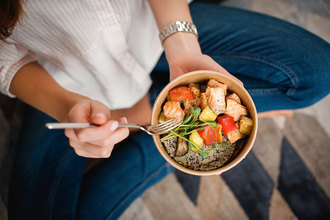Eating Guidelines for Gout
Gout is a type of arthritis. It occurs when high levels of uric acid cause crystals to form in your joints and soft tissues, leading to inflammation, pain and swelling. A common location for gout is the joint of the big toe at the ball of the foot. It can also occur in the arch, ankle, knee and hand. The joint may be swollen, red and tender to touch.
The amount of uric acid in your body depends on the following:
How much uric acid your body makes and gets rid of, certain medications that cause you to retain uric acid, and the amount of purine that you eat.
Uric acid is a normal waste product, formed from the breakdown of compounds in food called purines. It is excreted in the urine. When you have gout, your blood uric acid levels are higher than normal and this causes crystals to form.
Gout is usually treated with medications for either the symptoms (pain and inflammation) or to reduce uric acid levels. Diet can also help reduce uric acid levels and the risk for gout.
Reduce Purines:
Some food and beverages contain compounds called purines. Purines change to uric acid in the body. Meat, poultry and seafood are high in purines and can increase uric acid levels. Eating purines does not cause gout. Purines found in plant foods do not increase uric acid levels and are not a concern.
Risk Factors for Gout:
obesity
high alcohol intake
some cancers and blood diseases
kidney disease
some medications (aspirin, diuretics)
Dietary Recommendations to lower uric acid levels and reduce risk for gout attacks:
- Eat 2-3 servings of meat and alternatives per day and limit portions of meat and seafood as they are high in purines.
- Choose vegetable protein sources more often: beans, lentils, tofu, and unsalted nuts and seeds. Although some of these foods contain purines, they are not linked with increases in uric acid or risk for gout symptoms.
- Include milk and milk products daily. Consumption of milk products is associated with lower uric acid level and less gout.
- Make vegetables an important part of your diet. Aim to eat at least 4 servings of vegetables each day. Also, choose vegetables as a snack.
- Choose whole fruit instead of juice. Aim to have at least three servings of fruit each day.
- Avoid sugar and high-sugar foods and beverages such as pop, fruit drinks, specialty coffee and tea drinks, candy, and sugary desserts like pastries, donuts, cake, and cookies as these may increase uric acid levels.
2. Limit alcohol. Women no more than 10 drinks/week and men no more than 15 drinks/week. You may choose to avoid alcohol if you have painful gout.
One drink equals the following:
-341 mL (12 oz.) bottle of 5% beer, cider or cooler,
- 142 mL (5 oz.) glass of 12% wine, or
- 43 mL (1.5 oz.) shot of 40% spirits.
Alcohol, especially beer and hard liquor, can increase your risk of gout attacks. Wine does not seem to have the same effect.
3. Stay well hydrated. Aim to drink 2-3 L (8-12 cups) of fluids each day.
Water is your best choice. Drinking plenty of water will also help dilute uric acid in your urine and prevent kidney stones.
4. If weight loss is a goal for you, choose a weight loss plan that encourages slow, steady weight loss. Rapid weight loss or following a diet high in animal protein is not recommended because it could increase uric acid levels in your blood and the chance of a gout attack.
5. Drink Coffee in Moderation. Drinking coffee is linked with lower uric acid levels and reduced risk of gout. (max 4c/day)
6. Although there have been reports that cherries can reduce gout attacks, the evidence is not strong enough to support the recommendation. Eat Cherries as part of a healthy diet.














